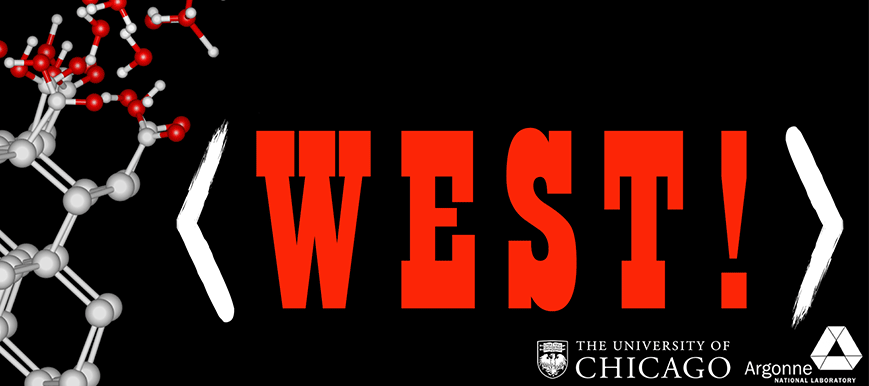September 28, 2015

by Argonne National Laboratory staff
Software that greatly improves the accuracy and efficiency of calculations of materials' properties from basic quantum principles has been released by scientists at the University of Chicago and the US Department of Energy’s Argonne National Laboratory.
Already in use by groups domestically and internationally, the open source software, called WEST, is available for free download at www.west-code.org. "We expect WEST to have a major impact in helping the prediction of new materials for energy conversion and storage," said Marco Govoni, WEST’s lead developer, who holds a joint research appointment between the University of Chicago and Argonne National Laboratory within the Institute for Molecular Engineering.
In the past 40 years, scientific computing has become increasingly important in all scientific disciplines. The collection and interpretation of most experimental data are carried out using computers, which are also used to provide numerical solutions of physical models with various degrees of complexity and sophistication. With decades of successful applications, high-performance computing is building toward a revolution in predicting and designing the fundamental properties of materials from numerical solutions of the basic laws of quantum mechanics.
"This field is growing and holds great promise," said Govoni, "especially in predicting materials for energy, where a quantum mechanical description of matter is of key importance, and where a tight connection between laboratory experiments and numerical simulations will greatly help the design of advanced materials for sustainable energy technologies."
In the area of energy conversion and storage, he said, scientists are striving to find effective ways to identify durable, inexpensive, non-toxic and disposable materials, for instance to provide higher capacity batteries and mimic photosynthesis. Other active areas of materials research include exploiting imperfections in certain solids to build quantum machines that can crack problems inaccessible to today’s technology.
Using carefully crafted algorithms, WEST can predict properties arising from the interaction of materials with light, which requires a high-level accuracy and implies a considerable computational cost. After the interaction with light, Govoni said, "relevant energy transformation processes typically occur in complex structures, including surfaces and interfaces. To study materials and their interfaces in ways that realistically represent experimental samples, we need efficient codes and highly accurate levels of theory. This is what we are trying to achieve in codes like WEST”.
“We use high-performance computing architectures, in particular at the Argonne Leadership Computing Facility (ALCF), a DOE Office of Science user facility, to conduct large-scale quantum simulations that are aimed at understanding, predicting and designing materials properties,” he said. “In order to do this, we need very accurate software that can tackle large problems.”
The algorithms implemented in WEST build on well-known theories. For example, density functional theory, developed in the 1960s, allows researchers to describe materials using their electron densities. This theory can predict many properties of a material, even help design materials that do not yet exist in nature or that are metastable (temporarily stable but not in their lowest, most stable energy state).
“Density functional theory is a very important tool, but in its present form, it’s not accurate enough to predict the energy levels required to understand the interaction of materials with light," Govoni said. The electron clouds that hold together matter interact with the same forces that act between classical, charged bodies, but because of their quantum nature, the many-body interactions between electrons need to be described collectively and with probability distributions. WEST uses scalable algorithms that deal efficiently with these complex many-body interactions.
“The WEST software scales well with modern high-performance parallel computers," Govoni said. "You can basically run a simulation using the entire BG/Q machine at Argonne, and we are now thinking about how to adapt the software to new upcoming computing architectures.” The novelty of WEST stems not only from efficiently parallelized workflows, but also from several algorithmic advances, such as the use of density-based linear response methods and the use of iterative matrix diagonalization techniques. WEST was released in June 2015, 50 years after the original works of Lars Hedin on the equations implemented in WEST; that work, also carried out at Argonne, revolutionized the description of electronic many-body interactions in materials. By making WEST public, researchers worldwide will have the means to exploit the accuracy of many-body perturbation theory through this powerful code.
University of Chicago professor Giulia Galli said WEST took years to develop and represents an effort that started in her group at University of California, Davis and continued once she moved to the University of Chicago in 2014. “WEST is not just a fast scalable code at the forefront of high-performance computing," Galli said. "It also contains several conceptual improvements that are enabling the study of systems of unprecedented size. We are employing WEST and other codes based on quantum mechanics, in particular the molecular dynamics code Qbox, developed by Prof. F. Gygi at UC Davis, to look for completely new materials, the materials of the next decade.” The activity of the Galli group, of which Govoni is part, is focused on understanding and predicting from first principles the properties of materials and molecules, including materials for energy, water and quantum materials.
The paper describing the WEST code has been published on the Journal of Chemical Theory and Computation in 2015. Besides ALCF, WEST is in use on the University of Chicago Research Computing Center's supercomputing cluster, Midway.